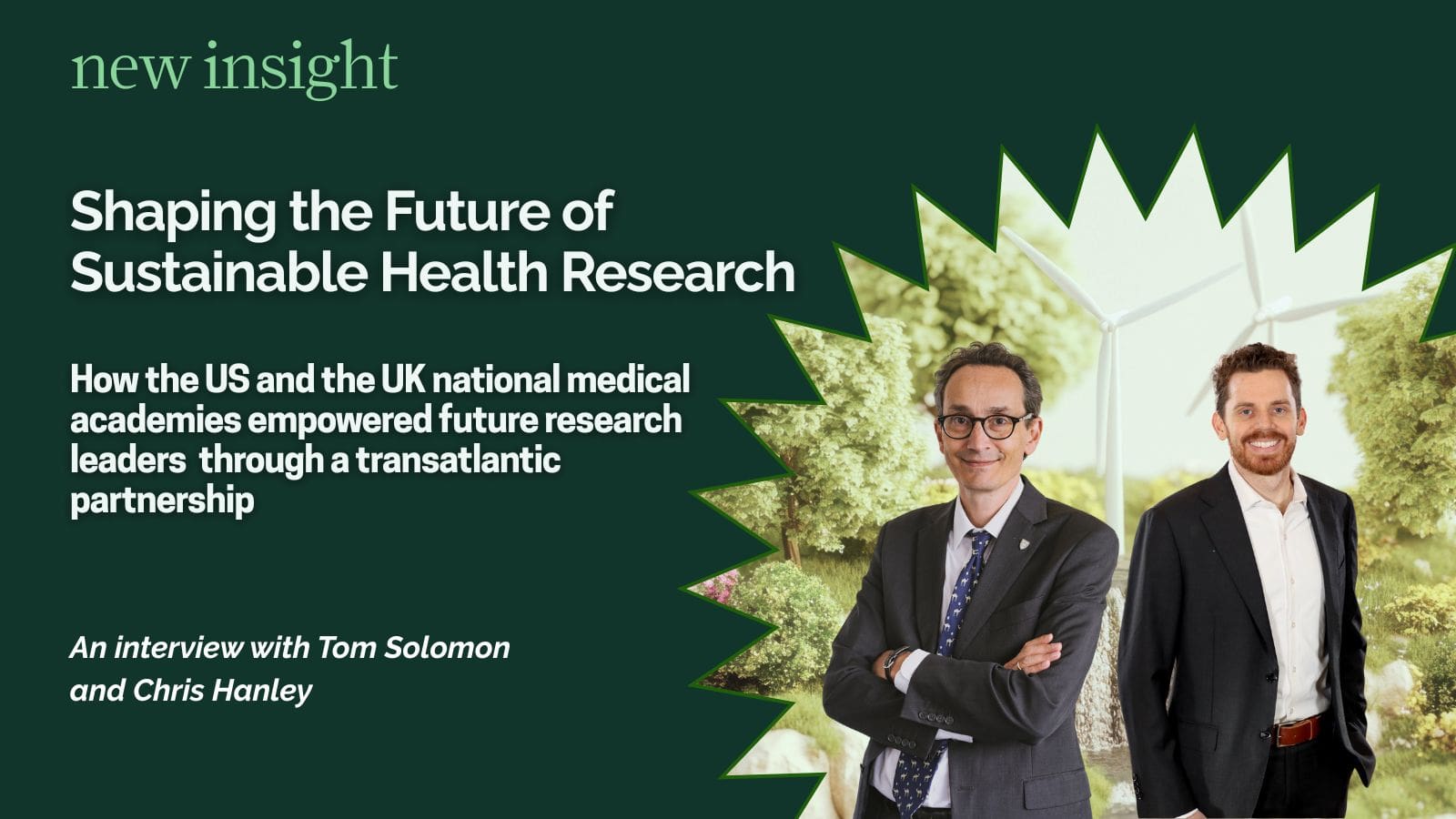
How the US and the UK national medical academies empowered future research leaders through a transatlantic partnership
Two years ago, Tom Solomon, International Vice President of the UK Academy of Medical Sciences, and Chris Hanley, Director of the Grand Challenge on Climate and Health at the US National Academy of Medicine, helped launch an ambitious transatlantic collaboration. Working alongside Program Leads Paula Williamson and Melissa Simon and project co-chairs Julia Wilson and Ying Goh, they helped to convene16 future research leaders from both countries to tackle a question with global stakes: how can health research be made more environmentally sustainable?
The effort culminated in For People, For Planet: Improving the Environmental Sustainability of Health Research, a policy report authored by the future research leaders, outlining steps to reduce the sector’s environmental footprint—from laboratory design to procurement, funding incentives, and regulatory frameworks. It provides academic institutions, funders, regulators, and industry with a starting point for advancing human health without undermining planetary health.
Yet the report itself may not be the most enduring outcome of this partnership. By placing future research leaders at the center of the process, the academies tested a new model of leadership: one that was unconventional, and ultimately transformative. These researchers, most from outside the climate and health space, brought urgency, fresh thinking, and cross-disciplinary expertise that reshaped not only the final report but also the institutions that supported them.
In the conversation that follows, Solomon and Hanley reflect on the origins of this transatlantic partnership, how navigating the risks were more than worth the rewards of giving future leaders the reins, and what success will look like in the years ahead.
The following interview has been edited for length and clarity.
What motivated the UK Academy of Medical Sciences and the US National Academy of Medicine to come together on this project, and what made this collaboration distinct?
Solomon: The US National Academy of Medicine and the UK Academy of Medical Sciences are strong partners and have worked together for years, having hosted a number of joint policy and scientific events. When I became International Vice President in 2021, I wanted to use this base to deliver a more ambitious collaboration. In 2022, the Academies co-hosted the Rosenthal Symposium in Washington, DC, which focused on climate change and global public health. The meeting was an opportunity to take stock of the urgent health impacts of climate change and the potential for decarbonization across health systems in both countries. It also highlighted the need for health voices to be stronger in climate debates and for researchers to work across disciplines. That event was a real success and became the starting point for this partnership. One of the priorities that came out of it was the importance of encouraging the next generation of researchers to take the lead, so from there we decided to establish a joint project led by emerging research leaders rather than by senior leadership.
Hanley: For me, another unique aspect was that the partnership wasn’t one academy leading and the other supporting; it was a 50/50 collaboration. Each sat equally in the driver’s seat. That model is not one I’ve seen often in multinational convenings and was what made this so valuable. I’m part of many initiatives where a single organization takes the lead and then invites others from different countries to join. Those can be effective, but this approach was different. We dove much deeper into shared lessons and learned from each other as we navigated the two years together.
“Sustainability has to become everybody’s business, not just the specialists.” – Tom Solomon
How did the experience of co-leading a transatlantic group of emerging research leaders shape the outcomes of this report?
Hanley: We didn’t know exactly how it would play out, and that was something we were okay with, but the program members exceeded expectations. Their day jobs were in fields outside climate and health, yet with guidance from experts like Sir Andy Haines they quickly got up to speed and took ownership. The quality of their work was remarkable, and it allowed us to step back into more of a support role rather than a directive one, which is unusual for us.
Solomon: It was a risk. The Academy had never delivered a policy project that was led by emerging research leaders, but it has worked where we saw wonderful leadership from all involved and the recommendations in this report are testament to this. And the fact that this wasn’t their usual field underscored an important point: sustainability has to become everybody’s business, not just the specialists.
What did you observe about how early career scientists are thinking about sustainability compared with established leaders?
Hanley: Generally, younger or earlier-career researchers bring more urgency. They see sustainability as the defining challenge of their generation and want to integrate it immediately. Another key point: the mix of junior and senior participants was powerful. The juniors brought urgency, while the seniors helped them understand how to pull the big policy levers. That cross-education was one of the most valuable outcomes of this project.
Solomon: For younger researchers, sustainability is built into their thinking from the start. For people like me, it can feel more like an afterthought. But in senior leadership roles, we focus on governance and structural changes like the environmental footprint of running our academy buildings. We need to drive positive changes that support a sustainable future, and different perspectives are essential to achieving this.
The report covers a wide range of recommendations. What were you and the group trying to solve, and what outcomes did you ultimately land on?
Hanley: The big question we started with was how to make health research more environmentally sustainable without losing sight of innovation or less resourced individuals or organizations. We knew research has a sizable carbon footprint—labs, trials, and even digital work like data storage and AI can be resource intensive—but there wasn’t a clear, coordinated path forward. What the program team produced was a roadmap that breaks the problem into six themes: data and metrics, funding, regulation, procurement, infrastructure, and capacity building. For each of those areas, they identified where we are now, what the gaps are, and concrete steps that funders, universities, regulators, and industry can take. They do so in a thoughtful way that prioritizes that no one is left behind and innovation can still shine through.
Funding bodies are identified as crucial levers for sustainability. How might funders balance sustainability expectations with the need to support innovation and equity in research?
Solomon: In my view, funders drive behavior. If they attach conditions, institutions adapt. For example, in the UK, funders required universities to meet gender equity standards under the Athena SWAN Charter before receiving certain grants. That worked. Now some funders require net-zero commitments, for example, Wellcome by 2030 and Cancer Research UK. Even pharmaceutical companies are building net-zero facilities. These rules encourage the sector to adapt, and people are beginning to deliver research within these constraints. However, as highlighted in the report, funders should work in collaboration with researchers, research organizations, other funders and wider stakeholders to ensure that sustainability expectations are realistic, equitable and continue to support innovation and equity in the research sector.
Hanley: The real challenge is ensuring sustainability is accessible to everyone. Strict requirements could exclude low-resource researchers and limit their contributions to the global body of knowledge. Collaboration is key. We won’t get it perfect at the first pass, but if we work together—funders, researchers, regulators—we can set achievable goals while striving for accelerated incrementalism.
“Funders, regulators, and researchers largely want the same outcomes, but if incentives are misaligned, it becomes a race to the bottom.” – Chris Hanley
The report outlines challenges with regulation and procurement. Where do you see the greatest opportunities for constructive alignment between researchers, regulators, and industry?
Solomon: Regulation works best when everyone is required to act together. If only a few actors adopt net-zero practices, they risk competitive disadvantages. But if regulators mandate standards across the board, industry adapts as a group. It’s similar to the food industry: companies say they can produce healthier products, but only if government requires everyone to do the same so they’re not penalized for going first. The same principle applies here: alignment across regulators, industry, and researchers is essential.
Hanley: It comes down to aligning incentives. Funders, regulators, and researchers largely want the same outcomes, but if incentives are misaligned, it becomes a race to the bottom. Collaboration and consistency across sectors can play a large role in solving this.
Now that the report is published, what practical first steps would you like to see universities, funders, or labs take to strengthen sustainability skills in their research communities?
Solomon: Reports like this put sustainability on the agenda. Universities, funders, and governments notice them, which helps prioritize action. But success isn’t just about producing a report, it’s about what happens next. For example, investment by research organizations and national and private funders in standardized training, sustainability education and sharing of best practice in environmentally sustainable research amongst researchers, laboratories and organizations and across career pathways would be a key first step. We need to keep engaging stakeholders, so they act on the recommendations. For the researchers involved, this may become a pivotal point in their careers—some may move into climate work permanently, while others gain a deeper understanding of policy and international collaboration. The transatlantic connections they’ve made could last a lifetime.
Hanley: I agree. The report is excellent, but our responsibility is to push it out, so it reaches the right people. We’ll highlight it at events like our Climate and Health Summit, Climate Week NYC, and London Climate Week. Dissemination is crucial, because if funders and institutions make sustainability a true priority, the steps outlined in the report are an excellent roadmap to lasting change.
“If five years from now we see [the researchers] leading new projects, shaping funding priorities, and building international networks, then we’ll know this work truly paid off.” – Chris Hanley
Looking ahead five years, what would success look like for this partnership and for efforts to embed sustainability in health research?
Solomon: In five years, I’d like to see some of the researchers who worked on this report in leadership roles, shaping climate and health policy and research at the highest levels. I’d also like to see universities and funders embedding sustainability in a routine way—carbon footprinting as standard, sustainable labs, procurement practices, and international partnerships modeled on this one. If those things happen, this project will have had a lasting impact.
Hanley: For me, success would mean two things. First, this partnership between the UK and US academies continues to thrive and inspires similar collaborations globally. Second, that the researchers who were part of this process carry forward the lessons they learned—not just about sustainability but also about how to work across policy, science, and borders. If five years from now we see them leading new projects, shaping funding priorities, and building international networks, then we’ll know this work truly paid off.

